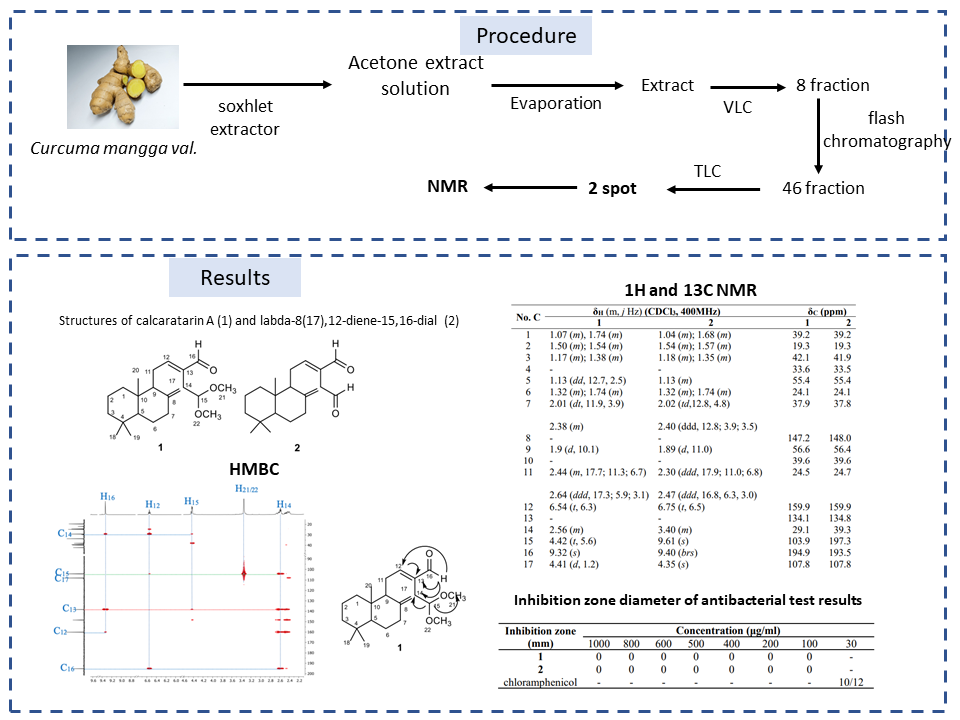Labdane Aldehyde Diterpenoids from Curcuma mangga Rhizome
Abstract

Curcuma mangga val. (Zingiberaceae) is one of the plants that used as traditional medicine by Indonesian. Several studies have been reported on the content of compounds of C. mangga, but it is not yet known which compounds have medicinal properties. In this study, two labdane diterpenes were isolated from the extract of rhizome of C. mangga. Determination of the structure conducted by NMR (1H, 13C, HSQC and HMBC) that obtained two compounds, calcaratarin A (1) and labda-8(17),12-diene-15,16-dial (2). Both compounds have an aldehyde functional group. However, both compounds did not show antibacterial activity on Escherichia coli.
References
[1] Gomes, T.A.T., Elias, W.P., Scaletsky, I.C.A., Guth B.E.C., Rodrigues, J.F., Piazza, R.M.F., Ferreira, L.C.S., and Martinez, M.B., Braz. J. Microbiol., 2016, 47S, 3-30.
[2] Allocati, N., Masulli, M., Alexeyev, M.F., Ilio, C.D. Int. J. Environ. Res. Public Health, 2013, 10, 6235-6254.
[3] Kaper, J.B., Nataro, J.P. and Mobley, H.L.T., Nat. Rev. Microbiol., 2004, 2, 123-140.
[4] Christenhusz, M.J.M. and Byng, J.W., Phytotaxa, 2016, 261(3), 201-217.
[5] Kaliyadasa E., and Samarasinghe, B.A., Afr. J. Agric. Res, 2019, 14(9), 519-531.
[6] Lim, T.K., Curcuma manga in: Edible Medicinal and Non-Medicinal Plants: 1st ed., (2016), 363-370, Springer, Cham,
[7] Sarjono, P.R., and Mulyani, N.S., Jurnal Sains & Matematika (JSM), 2007, 15(2), 89-93.
[8] Muchtaromah, B., Safitri, E.S., Fitriasari, P.D., and Istiwandhani, J., AIP Conference Proceedings, 2020, 2231, 030005.
[9] bin Jantan, I., Ahmad, A.S., Ali, N.A.M., Ahmad, A.R., Ibrahim, H., J. Essent Oil Res, 1999, 11, 719-723.
[10] Tg Kamazeri, Tg.S.A., Samah, O.A., Taher, M., Susanti, D., and Qaralleh, H., Asian Pac. j. trop. med., 2012,5(3), 202-209,
[11] Abas, F., Lajis, N.H., Shaari, K., Israf, D.A., Stanslas, J., Yusuf, U.K., and Raof, S.M., J. Nat. Prod., 2005, 68(7), 1090-1093.
[12] Malek, S.N.A., Lee, G.S., Hong, S.L., Yaacob, H., Wahab, N.A., Weber, J-F.F., and Shah, S.A.A., Molecules, 2011., 16, 4539-4548.
[13] Kaewkroek, K., Wattanapiromsakul, C., and Tewtrakul, S., Songklanakarin J. Sci. Technol, 2009, 31(3), 293-297.
[14] Kong, L-Y., Qin, M-J., and Niwa, M., J. Nat. Prod., 2000, 63, 939–942.
[15] Singh, S., Kumar, J.K., Saikia, D., Shanker, K., Thakur, J.P., Negi, A.S., and Banerjee, S., Eur. J. Med. Chem., 2010, 45(9), 4379-4382.
[16] Davis W.W. and Stout, T.R., Appl. Microbiol, 1971, 22(4), 659-665.
Refbacks
- There are currently no refbacks.

This work is licensed under a Creative Commons Attribution-NonCommercial 4.0 International License.








